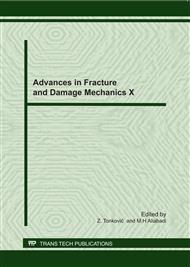[1]
M. Ben Bettaieb, X. Lemoine, O. Bouaziz, L. Duchêne, A-M. Habraken, Damage initiation and growth in DP steel sheets, Mechanics of Materials.
Google Scholar
[2]
M. Ben Bettaieb, X. Lemoine, L. Duchêne, A-M. Habraken, On the numerical integration of an advanced Gurson model, International Journal for Numerical Methods in Engineering, DOI: 10. 1002/nme. 3010.
DOI: 10.1002/nme.3010
Google Scholar
[3]
E. Maire, O. Bouaziz, M. Di Michiel, C. Verdu, Initiation and growth of damage in a dual-phase steel observed by X-ray microtomography, Acta Materialia 56 (18), 2008, 4954-4964.
DOI: 10.1016/j.actamat.2008.06.015
Google Scholar
[4]
C. Landron, O. Bouaziz, E. Maire, J. Adrien, Characterization and modeling of void nucleation by interface decohesion in dual phase steels, Scripta Materialia 63 (10), 2010, 973-976.
DOI: 10.1016/j.scriptamat.2010.07.021
Google Scholar
[5]
Gurson, A.L., 1977. Continuum theory of ductile rupture by void nucleation and growth: part I-yield criteria and flow rules for porous ductile media, J. Eng. Mater. Technol., 99, 2-15.
DOI: 10.2172/7351470
Google Scholar
[6]
Tvergaard, V., Needleman, A., 1984. Analysis of the Cup-cone Fracture in a Round Tensile Bar. Acta Metall. 32, 157-169.
DOI: 10.1016/0001-6160(84)90213-x
Google Scholar
[7]
Benzerga, A.A., Besson, J., 2001. Plastic potentials for anisotropic porous solids, Eur. J. Mech. A-Solids. 20, 397-434.
DOI: 10.1016/s0997-7538(01)01147-0
Google Scholar
[8]
Pardoen, T., 2006. Numerical simulation of low stress triaxiality ductile fracture, Comput. Struct., 84, 1641-1650.
DOI: 10.1016/j.compstruc.2006.05.001
Google Scholar


